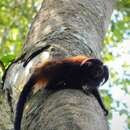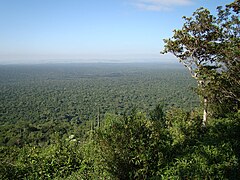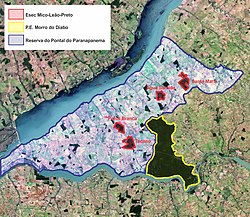en
names in breadcrumbs


The main predators of golden-rumped lion tamarins are small cats, birds of prey, and snakes. They avoid predation by being part of a social organization, so that more individuals are alert to potential dangers and will give warning signals to other members of their troupe. (Wolters 1990)
Known Predators:
L. chrysopygus is covered almost completely in silky, dense black hair. The only place this differs is in the hind quarters. The thighs, buttocks, and base of the tail are colored a reddish-brown. This is what gives the animal its common name, golden-rumped lion tamarin. The face of L. chrysopygus is not haired, as well as the hands and feet, these are colored dark gray to black. The hind limbs are generally longer than the forelimbs and the tail is not prehensile. All digits have a pointed sickle shaped nail, which is used for gripping trees, except the big toe which has a flat nail. The dental formula is as follows, 2/2 incisors, 1/1 canines, 3/3 premolars, 2/2 molars. Body length in L. chrysopygus is between 20 cm and 33.5 cm, tail length is usually 31.5 to 40 cm, and mass ranges from 300 to 700 g. (Beacham 1998; Nowak 1999; Wolters 1990)
Range mass: 300 to 700 g.
Average mass: 572.5 g.
Range length: 20 to 33.5 cm.
Other Physical Features: endothermic ; bilateral symmetry
Leontopithecus chrysopygus in the wild will live for approximately ten years. In captivity the longest lived golden-rumped lion tamarin lived for 28 years. (Nowak 1999)
Average lifespan
Status: wild: 10 years.
Range lifespan
Status: captivity: 28 (high) years.
Average lifespan
Status: captivity: 17.9 years.
Leontopithecus chrysopygus lives primarily in semideciduous forest of Sao Paulo. But it has also been know to occupy swamp forest and macega, a forest made up of mainly small bush-like trees. In these forests, L. chrysopygus lives approximately 3 to 12 meters above the ground, rarely going to the forest floor, giving it the classification of arboreal.
Range elevation: 0 to 700 m.
Habitat Regions: tropical ; terrestrial
Terrestrial Biomes: forest ; rainforest
Golden-rumped lion tamarins (Leontopithecus chrysopygus) at one time inhabited the vast tropical forest in the Central and Western portions of the state of Sao Paulo, Brazil. Now L. chrysopygus is limited to only two areas. One is the 375 square kilometer Morro do Diabo State Forest Reserve in southwesten Sao Paulo. The other is the Caiteus Reserve, a 23 square kilometer reserve in central Sao Paulo. (Beacham 1998)
Biogeographic Regions: neotropical (Native )
Perception Channels: tactile ; chemical
L. chrysopygus is listed as one of the world's rarest mammals. It is estimated that only about 700 are still living in both the wild and captivity. (Massicot 2001)
US Federal List: threatened
CITES: appendix i
IUCN Red List of Threatened Species: endangered
There are no negative effects of lion tamarins on humans.
L. chrysopygus is periodically captured and sold in Brazil as pets, though this has a negative impact on this imperiled species. The charismatic quality of lion tamarins makes them excellent candidates for ecotourism activities. (Beacham 1998)
Positive Impacts: pet trade ; ecotourism
Golden-rumped lion tamarins may be important as seed dispersers in the ecosystems in which they live.
Leontopithecus chrysopygus eats mainly insects and fruits. When they are able to catch them, L. chrysopygus will eat small lizards, small birds, bird eggs, and small vertebrates. (Massicot 2001)
Animal Foods: birds; reptiles; eggs; insects
Plant Foods: fruit
Primary Diet: omnivore
Most cases have found L. chrysopygus to be monogamous when mating but there has been some polyandy observed in certain populations. In populations where there is more than one adult male per social group the female may mate with several males to confuse the males as to paternity of her young. This causes males to provide assistance in the care of offspring that may be their own.
Mating System: monogamous ; polyandrous
Golden-rumped lion tamarins give birth most frequently to twins, though triplets and quadruplets have been reported. In other species of lion tamarin, gestation lasts from 125 to 132 days. Lion tamarins give birth during the rainy season, usually from September through March.
Breeding season: Breeding occurs from September through March, the wet season..
Range number of offspring: 1 to 4.
Average number of offspring: 2.
Range gestation period: 125 to 132 days.
Range weaning age: 2 to 3 months.
Range age at sexual or reproductive maturity (female): 16 to 24 months.
Range age at sexual or reproductive maturity (male): 16 to 24 months.
Key Reproductive Features: gonochoric/gonochoristic/dioecious (sexes separate); sexual
Both male and female golden-rumped lion tamarins aid in the rearing of offspring. The young are born well-furred and with their eyes open, but are entirely dependent on adults for their care. For the first 2 to 3 weeks newborns stay primarily with the mother. After three weeks the father will carry the young for much of the day, bringing them to their mother every 2 to 3 hours for feeding. The offspring are weaned after 2 to 3 months but usually don't leave the family group until they reach sexual maturity, at 16 to 24 months. (Nowak 1999)
Parental Investment: precocial ; pre-fertilization (Provisioning, Protecting: Female); pre-hatching/birth (Provisioning: Female, Protecting: Female); pre-weaning/fledging (Provisioning: Female, Protecting: Male, Female); pre-independence (Protecting: Male, Female); post-independence association with parents; extended period of juvenile learning
The black lion tamarin (Leontopithecus chrysopygus), also known as the golden-rumped lion tamarin, is a lion tamarin endemic to the Brazilian state of São Paulo, almost exclusively at the Morro do Diabo State Park. Its limited geographical range makes it the rarest of the New World monkeys, with little known about it.[5] It was thought to be extinct for 65 years until its rediscovery in 1970.[6] In 2016 an adult couple was found to the east, in the Caetetus Ecological Station, after six years with no sightings.[7]
A 2020 assessment by the International Union for Conservation of Nature (IUCN) estimated that there was 1,600 individuals living in the wild, 1,200 of which are found in Morro do Diabo State Park.[3] They are usually found in groups of 4 to 9, living in the secondary and primary forests along the circumference of its home range.
On average, the black lion tamarin weighs 300–700 grams (11–25 oz).[8]
The classification of the black lion tamarin was debated, as one group of taxonomists classified the lion tamarins by their geography, while other taxonomists placed them all into one species and then divided them into subspecies. More recently, taxonomists have agreed to base classification predominantly on their geography, though sometimes characteristics such as long calls are used to classify different species, similar to the use of bird songs in taxonomy.[5] For differentiating within Leontopithecus, the black lion tamarin is categorized as starting its call at the lowest note and going through the greatest range of pitch.[5]
The diet of the black lion tamarin is seasonal and varies with the habitats it moves through.[6] When the tamarin is in the dryland forest, it usually eats a variety of fruits, whereas in a swampy environment it predominantly feeds on the gum of various trees.[6] In addition to seasonal variation, the black lion tamarin exhibits daily and monthly cycles of food preferences.[9]
Independent of the environment it occupies, a tamarin spends long periods each day searching for different types of insects and spiders to feed on. On average, 80% of its time foraging is spent searching for insects,[6] such as by foraging the forest floor. The tamarin's foraging locations are very intentional: it spends extended periods of time looking under dry palm leaves, in loose bark, and in tree cavities, with hands that have specialized fingers for prying.[3] The tamarin also positions itself in trees and scans for insects from above, usually four meters above the forest floor.
The black lion tamarin eats the gum and fruit of trees, climbing up to ten meters to reach them and as these are easily found, the tamarin spends 12.8% of its day obtaining them, rather than the 41.2% of the day spent foraging for insects in the high trees.[6]
Black lion tamarins mate and have offspring during the spring, summer, and fall months (August to March in Brazil).[10] Females usually have one litter per year, though 20% females produce two litters per year.[10] The mean litter size is two infants.[10]
Most mammals produce a 50:50 ratio of males to females. The black lion tamarin population almost always produce a 60:40 male to female ratio.[10]
Most infants deaths occur within the first two weeks of birth, with newborns of first-time mothers having the lowest survival rates. The number of tamarins that survive to adulthood in the wild is 10% higher than those in captivity.[10]
During the first few months after birth, the infant is unable to obtain food on its own. For this reason, the infant rides on the parent's back and receives food from the parents. It drinks milk in the 4 to 5 weeks after birth; after that, the parents and other group-members share food with the infant. Sharing involves both offers from the parents and begging by the infant. Usually, until the age of approximately 15 weeks, the infant will receive the majority of its food (especially insects) from others.[11] The number of offers from group-members peaks at week 7; after week 15, sharing slowly declines, stopping by week 26.[11]

Within Leontopithecus, the black lion tamarin is the largest in size and has the lowest-pitched calls, using longer notes than other species.[5] The black lion tamarin use calls to defend territory, maintain cohesion within the group, attract a mate, and contact individuals who might be lost. Most calls can be recorded in the morning, and can be attributed to the reunion of mated pairs. Mated pairs are mostly monogamous but polyandry has been observed in some populations.[8]

The black lion tamarin is rated endangered by the IUCN Red List due to its declining population trend.[12] The main threat against it is the destruction of its habitat through deforestation,[6] though it is also threatened by being hunted in unprotected forests, such as the Fazenda Rio Claro and the Fazenda Tucano (which have roughly 3.66 and 1.0 individuals per square kilometer respectively).[12]
There have been several attempts to bring black lion tamarins into captivity and to salvage what little habitat they have left within the Morro do Diabo State Park, as well as to increase breeding rates. Their population decline in the wild, however, could cause the black lion tamarins to become entirely endemic to the Morro do Diabo.
The black lion tamarin (Leontopithecus chrysopygus), also known as the golden-rumped lion tamarin, is a lion tamarin endemic to the Brazilian state of São Paulo, almost exclusively at the Morro do Diabo State Park. Its limited geographical range makes it the rarest of the New World monkeys, with little known about it. It was thought to be extinct for 65 years until its rediscovery in 1970. In 2016 an adult couple was found to the east, in the Caetetus Ecological Station, after six years with no sightings.
A 2020 assessment by the International Union for Conservation of Nature (IUCN) estimated that there was 1,600 individuals living in the wild, 1,200 of which are found in Morro do Diabo State Park. They are usually found in groups of 4 to 9, living in the secondary and primary forests along the circumference of its home range.
On average, the black lion tamarin weighs 300–700 grams (11–25 oz).